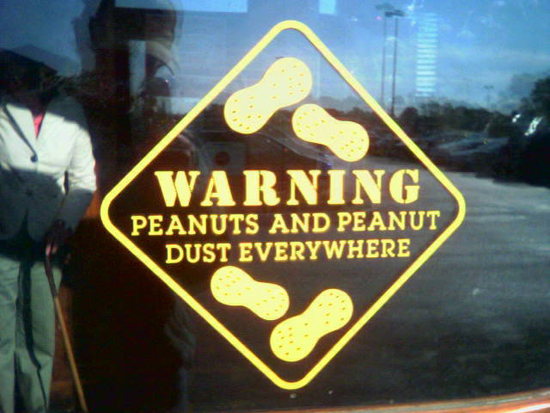How Peanut Allergy Affects Children
Anaphylaxis May Result from Consuming Dairy Products, Nuts, Shellfish, and Food Additives
Copyright © 2012 Vicki Riviera All Rights Reserved; content may not be copied, rewritten, or republished without written permission; Posted June 9, 2012


According to Webmd.com, a survey conducted in 2010 indicated that out of 40,000 U.S. families surveyed, peanut allergy was the most prevalent allergy afflicting children.
Milk and shellfish followed close behind. Further studies indicate that the number of children with peanut afflictions have tripled among kids since 1997.
Avoiding Allergic Reactions
Frankly, the only way to avoid an allergic reaction to peanuts is to avoid them. No case is exactly the same; sensitivity varies. On the mild end of the spectrum, some kids can simply avoid PB&J sandwiches and other chow containing peanuts.
Others will experience a reaction by touching them, and some by consuming items that have been in contact with equipment that processed with them.
On the most sensitive end of the spectrum, a reaction can manifest by simply breathing the air near other children who are eating them. Ironically, many children suffering with from this condition can consume some forms of peanut oil safely.
One way to avoid problems is by packing a safe lunch at home, but not that is not always a bulletproof method because parents have no way of knowing what other children’s meals contain and children tend to share their food.
Of course, your kiddo probably doesn’t know exactly what is in the cookie or sandwich he or she swaps with the kid on the next stool. You must ensure that your child knows to comply with a no-swapping rule for lunches and snacks.
Another insidious way contact can be made is when participating in arts & crafts or science projects. These sometimes use food as components and may expose students to allergens.
Be sure to inform the school staff verbally and in writing (CYA) if your child has any food allergies.
Know the Signs of Allergic Reaction
Anaphylaxis is the high-dollar name for a reaction to a food allergy. It manifests as a serious, severe, and possibly fatal allergic reaction. Yes, it may be classified as a medical emergency.Food allergies are know to be the most common cause of this and kids suffering from asthma or who have experienced an anaphylactic reaction previously are increasingly more at risk.
Which foods are most likely to trigger a reaction? Most doctors and researchers agree that they are peanuts, tree nuts, fish, and shellfish, in that order. In some cases, dairy products can also produce a reaction.
Milk allergies are sometimes confused with lactose intolerance which is the inability to properly digest the sugar present in milk and other dairy products.
The symptoms seem identical. For example, both conditions may manifest as vomiting and/or stomachache within about thirty minutes. Your doctor can help you discover which condition your child has. Hopefully not both!
The symptoms of an anaphylactic reaction to food generally become evident within one hour, but that is only a general guideline. They can also show up as early as within seconds or as late as several hours. But that’s not the worse of it; in about one-third of cases, a secondary reaction crops up hours later.
And because of that, even if a child appears to have recovered from a dangerous reaction, it is important that she should goes to the hospital and remain there for observation for four to six hours just to err on the side of caution.
Some early symptoms of an anaphylactic reaction are shortness of breath, swelling, and itching. It may begin seemingly innocent, but may become life-threatening within just a few minutes.If you keep epinephrine on hand (and you should if your child has had a reaction before), inject it as soon as possible and then call 911.
However, if you do not have epinephrine, call 911 right away. Obviously, the simplest and best way to prevent anaphylaxis is to do everything you can to help your child avoid food triggers. That means keep danger foods out of the house and be cautious where you dine out.
Are Other Nuts Off-Limits?


Not necessarily. Why not? It’s interesting to note that peanuts aren’t nuts at all. Rather, they’re classified as legumes and are related to peas and beans. But tree nuts like cashews, walnuts, pecans, and almonds are different species altogether.
So the good new is that a kid diagnosed with a peanut allergy might still be perfectly OK enjoying true nuts. The caveat is they must be prepared in a facility that doesn’t also process peanuts.
This should be indicated on the packaging. However, note that the peanut protein structure is quite close to that of tree nuts, so some children are allergic to them as well.
Unfortunately, almost all children suffering from peanut, tree nut, or seafood allergies will never grow out of them. But many will say goodbye to egg, dairy, soy, and wheat allergies by the the time they graduate high school, sometimes, well before that.
Allergy Facts to Know
- Additives that food processors add such as preservatives, corn syrup, and dyes can also trigger reactions. However, these are likely to be chemical reactions, not allergic reactions, and are not as common.
- When should foods be introduced into a child’s diet? Anytime. Physicians once thought a delay could lower the chance of susceptibility, but this is no longer believed to be the case.
- Is there a cure? Not at this time. Whereas respiratory allergies can be treated with allergy shots, there is nothing on the market for foods.
- A liquid antihistamine like diphenhydramine, bought over-the-counter, can help for a minor, isolated allergic reaction, but consult with your doctor first.
Disclaimer: The author is not a doctor. This article is informational material only and does not constitute medical advice. Contact your physician for all medical conditions.
More Recipe and Nutrition Articles
- Healthy Red Blood Cells Need Vitamin B12
- 3 Herbal Teas for Immune System Support
- Should You Steer Clear of Genetically Modified Food?
- Understanding Nutrition Labels and Serving Size
Website © 2012 KSmith Media, LLC; all rights reserved; content may not be copied, rewritten, or republished without written permission; Webmaster’s Google profile

